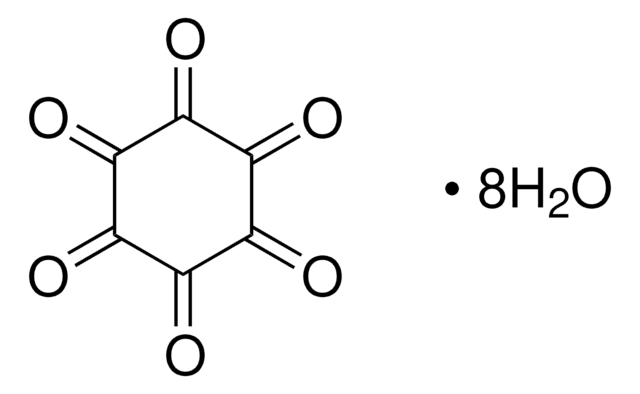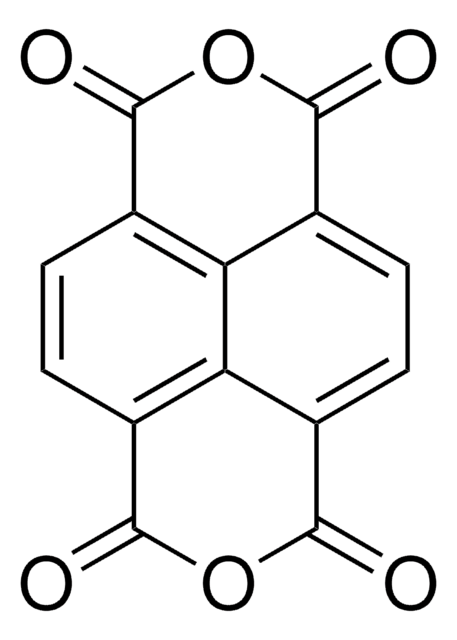Wszystkie zdjęcia(1)
Kluczowe dokumenty
305065
1,2,4,5-Benzenetetramine tetrahydrochloride
≥95%
Synonim(y):
1,2,4,5-Tetraaminobenzene tetrahydrochloride
Zaloguj sięWyświetlanie cen organizacyjnych i kontraktowych
About This Item
Wzór liniowy:
C6H2(NH2)4·4HCl
Numer CAS:
Masa cząsteczkowa:
284.01
Beilstein:
3701344
Numer WE:
Numer MDL:
Kod UNSPSC:
12162002
Identyfikator substancji w PubChem:
NACRES:
NA.23
Polecane produkty
Poziom jakości
Próba
≥95%
≥95.0% (AT)
mp
≥300 °C (lit.)
ciąg SMILES
Cl.Cl.Cl.Cl.Nc1cc(N)c(N)cc1N
InChI
1S/C6H10N4.4ClH/c7-3-1-4(8)6(10)2-5(3)9;;;;/h1-2H,7-10H2;4*1H
Klucz InChI
BZDGCIJWPWHAOF-UHFFFAOYSA-N
Szukasz podobnych produktów? Odwiedź Przewodnik dotyczący porównywania produktów
Opis ogólny
1,2,4,5-Benzenetetraminetetrahydrochloride is widely used as a novel source of carbon and nitrogen insynthesizing benzimidazole-linked polymers and carbon dot nanomaterials.
Zastosowanie
1,2,4,5-Benzenetetramine tetrahydrochloride can be used as a precursor in the synthesis of:
- A pyrene-based benzimidazole-linked polymer by the co-condensation with 1,3,6,8-tetrakis(4-formylphenyl)pyrene in dimethylformamide.
- Triazine-based benzimidazole-linked polymers for highly selective CO2 capture.
- Nitrogen-doped carbon dots (NCDs) by simple hydrothermal method, applicable as a highly selective fluorescent probe for sensing Mg2+ ions in an aqueous solution.
- Red-emitting carbon dots via the solvothermal method.
Ta strona może zawierać tekst przetłumaczony maszynowo.
Kod klasy składowania
11 - Combustible Solids
Klasa zagrożenia wodnego (WGK)
WGK 3
Temperatura zapłonu (°F)
Not applicable
Temperatura zapłonu (°C)
Not applicable
Środki ochrony indywidualnej
dust mask type N95 (US), Eyeshields, Gloves
Wybierz jedną z najnowszych wersji:
Masz już ten produkt?
Dokumenty związane z niedawno zakupionymi produktami zostały zamieszczone w Bibliotece dokumentów.
Klienci oglądali również te produkty
Halszka Ponamarczuk et al.
Frontiers in bioscience (Landmark edition), 23, 1612-1627 (2018-01-03)
Protein disulfide isomerase (PDI) is an abundant reticulum endoplasmic protein but also acts as an important functional regulator of some extracellular surface proteins. Recent studies suggest that PDI plays a role in integrin activation and thrombus formation. The aim of
Daisuke Aoyama et al.
PloS one, 8(11), e81133-e81133 (2013-11-28)
Transforming growth factor β (TGFβ) derived from the tumor microenvironment induces malignant phenotypes such as epithelial-mesenchymal transition (EMT) and aberrant cell motility in lung cancers. TGFβ-induced translocation of β-catenin from E-cadherin complexes into the cytoplasm is involved in the transcription
Friedrich Erhart et al.
NPJ vaccines, 5, 5-5 (2020-01-24)
Glioblastoma is the most prevalent and aggressive brain cancer. With a median overall survival of ~15-20 months under standard therapy, novel treatment approaches are desperately needed. A recent phase II clinical trial with a personalized immunotherapy based on tumor lysate-charged
Hao Huang et al.
Advanced science (Weinheim, Baden-Wurttemberg, Germany), 7(9), 2000012-2000012 (2020-05-10)
The 2D conductive metal-organic frameworks (MOFs) are expected to be an ideal electrocatalyst due to their high utilization of metal atoms. Exploring a new conjugated ligand with extra active metallic center can further boost the structural advantages of conductive MOFs.
Lei Wang et al.
Nanoscale, 9(12), 4090-4096 (2017-03-16)
Nanostructured semiconducting polymers have emerged as a very promising class of metal-free photocatalytic materials for solar water splitting. However, they generally exhibit low efficiency and lack the ability to utilize long-wavelength photons in a photocatalytic oxygen evolution reaction (OER). Here
Nasz zespół naukowców ma doświadczenie we wszystkich obszarach badań, w tym w naukach przyrodniczych, materiałoznawstwie, syntezie chemicznej, chromatografii, analityce i wielu innych dziedzinach.
Skontaktuj się z zespołem ds. pomocy technicznej



![Dipyrazino[2,3-f:2′,3′-h]quinoxaline-2,3,6,7,10,11-hexacarbonitrile 95% (HPLC)](/deepweb/assets/sigmaaldrich/product/structures/151/558/c0e2c95f-5228-4864-a7a5-4b9765a19840/640/c0e2c95f-5228-4864-a7a5-4b9765a19840.png)





